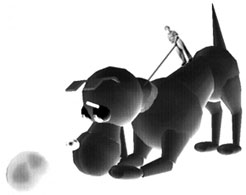Dedication
Introduction
Dan Ariely
Walter Bender
Steve Benton
Bruce Blumberg
V. Michael Bove, Jr.
Cynthia Breazeal
Ike Chuang
Chris Csikszentmihályi
Glorianna Davenport
Judith Donath
Neil Gershenfeld
Hiroshi Ishii
Joe Jacobson
Andy Lippman
Tod Machover
John Maeda
Scott Manalis
Marvin Minsky
William J. Mitchell
Seymour Papert
Joe Paradiso
Sandy Pentland
Rosalind Picard
Mitchel Resnick
Deb Roy
Chris Schmandt
Ted Selker
Barry Vercoe
Bruce Blumberg
My passion is to create creatures whose behavior, form, and underlying architecture not only inform our understanding of the natural intelligence displayed by animals and ultimately ourselves, but that also touch a person interacting with them on a profound personal level.
I am as concerned with the elegance, simplicity, and beauty of the underlying ideas as I am with the observable form and behavior. Much as an artist does not simply record what is there, but rather shows what he or she sees, so too do I view the creatures that we create as personal statements that, ideally, celebrate their subject but also challenge us to ask important questions about the nature and meaning of intelligence, as well as our relationship to, and with, animals.
I view the synthetic creatures that we create as personal statements that challenge us to ask important questions about the nature and meaning of intelligence, as well as about our relationship to, and with, animals.
 At the heart of this work is the search for the "computational scaffolding" or, alternatively, "conceptual primitives" that form the basis of commonsensical behavior and learning. Rather than taking a top-down or bottom-up approach, we start in the middle, informed by nature, and ask: "What does the observed behavior of animals such as dogs seem to imply about the underlying representations and processes that allow them to behave and learn in a commonsensical manner?" Our belief is that the best way to explore this question is to build synthetic characters that solve similar problems, and by doing so, the key insights will emerge. Our expectation is that through this work we will uncover "catalytic" representations and processes whose presence bootstraps more powerful ones. By doing so, the work will not only inform top-down and bottom-up approaches, but will also inform our understanding of the natural phenomena.
At the heart of this work is the search for the "computational scaffolding" or, alternatively, "conceptual primitives" that form the basis of commonsensical behavior and learning. Rather than taking a top-down or bottom-up approach, we start in the middle, informed by nature, and ask: "What does the observed behavior of animals such as dogs seem to imply about the underlying representations and processes that allow them to behave and learn in a commonsensical manner?" Our belief is that the best way to explore this question is to build synthetic characters that solve similar problems, and by doing so, the key insights will emerge. Our expectation is that through this work we will uncover "catalytic" representations and processes whose presence bootstraps more powerful ones. By doing so, the work will not only inform top-down and bottom-up approaches, but will also inform our understanding of the natural phenomena.
The theme of "unify and conquer" runs throughout our work. We believe that the problems of learning, behavior, emotion, and motivation are best understood within the context of a complete system functioning in a specific world with its attendant constraints and regularities. Indeed, by taking advantage of the regularities of the world, and the presence of the other components, the solution to each becomes easier.
An increasingly important aspect of our work is in understanding not only how to build systems that can learn, but also how to train these systems, and indeed how to make it easy to train them. The importance of this is that we are rapidly getting to the point at which our ability to build complex systems is outstripping our ability to design or understand the resulting behavior. The solution to this problem is to understand not only how to make these systems "trainable" but also how best to train them. Once again, by taking our inspiration from animal training, and by viewing learning and training as a coupled system, we believe we will be able to gain important insights into each and to address what may become one of the key challenges of complex system design in the future.
Favorite childhood toys: first, my Teddy Bear and stuffed dog, Rover; then my hamster, Snagglepuss